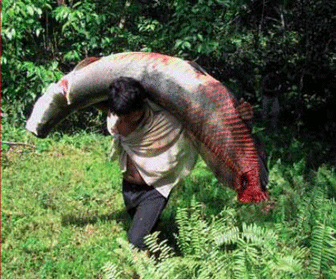Captive breeding of monster Amazon fish could feed people and save it from depletion
mongabay.com
November 26, 2008
|
|
A new technique for sexing a giant Amazon fish may help create a sustainable source of protein in South America, report researchers writing in Fish Physiology and Biochemistry.
Facing depletion throughout its range due to overfishing, the pirarucu (Arapaima gigas) remains an important food fish for Amazon dwellers, including rapidly expanding urban populations in the region. Efforts to farm the species — which can attain a length of 13 feet (4 meters) and 450 pounds (200 kg) — have been slowed by its need for large breeding ponds and difficulties in distinguishing between the sexes, which forces breeders to introduce a large stock of potential mates into giant ponds to ensure pairing.
 Captive-bred specimen weighing over 70 kg and 2 m long. Photo courtesy of Jésus Nuñez, IRD Paris |
In a development that helps overcome these hurdles, researchers from Institut de Recherche pour le Développement (IRD) in Paris, France and the Instituto de Investigaciones de la Amazonía Peruana in Iquitos, Peru, have devised a blood test to sex the Arapaima. The test will allow fish farmers to introduce equal numbers of male and female individuals into smaller ponds in order to attain much higher reproduction rates and therefore yields — up to 40 metric tons of fish from a single pair. IRD says the development may make Arapaima farming one of the most productive forms of aquaculture in the world. Importantly, captive breeding would also help reduce pressure on wild populations.
Citation: F. Chu-Koo, R. Dugué, M. Alván Aguilar, A. Casanova Daza, F. Alcántara Bocanegra, C. Chávez Veintemilla, F. Duponchelle, J.-F. Renno, Salvador Tello and J. Nuñez. Gender determination in the Paiche or Pirarucu ( Arapaima gigas ) using plasma vitellogenin, 17ß-estradiol, and 11-ketotestosterone levels. Fish Physiology and Biochemistry, DOI: 10.1007/s10695-008-9211-8